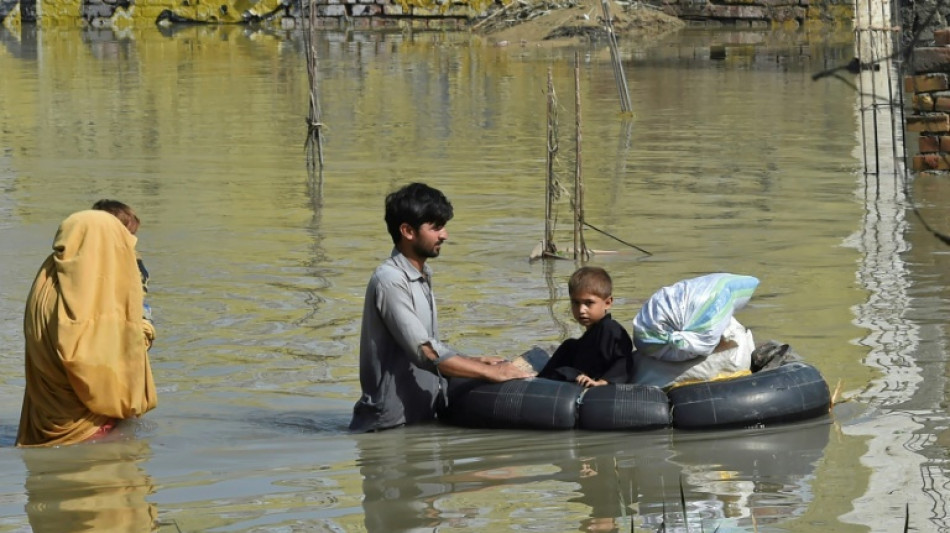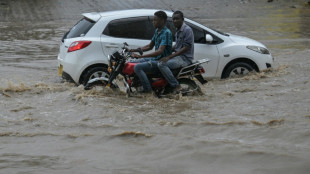
-
 Kenya's economy faces climate change risks: World Bank
Kenya's economy faces climate change risks: World Bank
-
Campaigning starts in Central African Republic quadruple election

-
 'Stop the slaughter': French farmers block roads over cow disease cull
'Stop the slaughter': French farmers block roads over cow disease cull
-
First urban cable car unveiled outside Paris

-
 Why SpaceX IPO plan is generating so much buzz
Why SpaceX IPO plan is generating so much buzz
-
US unseals warrant for tanker seized off Venezuelan coast

-
 World stocks mostly slide, consolidating Fed-fuelled gains
World stocks mostly slide, consolidating Fed-fuelled gains
-
Crypto firm Tether bids for Juventus, is quickly rebuffed

-
 UK's king shares 'good news' that cancer treatment will be reduced in 2026
UK's king shares 'good news' that cancer treatment will be reduced in 2026
-
Can Venezuela survive US targeting its oil tankers?

-
 Salah admired from afar in his Egypt home village as club tensions swirl
Salah admired from afar in his Egypt home village as club tensions swirl
-
World stocks retrench, consolidating Fed-fuelled gains

-
 Iran frees child bride sentenced to death over husband's killing: activists
Iran frees child bride sentenced to death over husband's killing: activists
-
World stocks consolidate Fed-fuelled gains

-
 France updates net-zero plan, with fossil fuel phaseout
France updates net-zero plan, with fossil fuel phaseout
-
Stocks rally in wake of Fed rate cut

-
 EU agrees recycled plastic targets for cars
EU agrees recycled plastic targets for cars
-
British porn star to be deported from Bali after small fine

-
 British porn star fined, faces imminent Bali deportation
British porn star fined, faces imminent Bali deportation
-
Spain opens doors to descendants of Franco-era exiles

-
 Indonesia floods were 'extinction level' for rare orangutans
Indonesia floods were 'extinction level' for rare orangutans
-
Thai teacher finds 'peace amidst chaos' painting bunker murals

-
 Japan bear victim's watch shows last movements
Japan bear victim's watch shows last movements
-
South Korea exam chief quits over complaints of too-hard tests

-
 French indie 'Clair Obscur' dominates Game Awards
French indie 'Clair Obscur' dominates Game Awards
-
South Korea exam chief resigns after tests dubbed too hard

-
 Asian markets track Wall St record after Fed cut
Asian markets track Wall St record after Fed cut
-
Laughing about science more important than ever: Ig Nobel founder

-
 Vaccines do not cause autism: WHO
Vaccines do not cause autism: WHO
-
Crypto mogul Do Kwon sentenced to 15 years for fraud: US media

-
 'In her prime': Rare blooming of palm trees in Rio
'In her prime': Rare blooming of palm trees in Rio
-
Make your own Mickey Mouse clip - Disney embraces AI

-
 OpenAI beefs up GPT models in AI race with Google
OpenAI beefs up GPT models in AI race with Google
-
Dark, wet, choppy: Machado's secret sea escape from Venezuela

-
 Cyclone causes blackout, flight chaos in Brazil's Sao Paulo
Cyclone causes blackout, flight chaos in Brazil's Sao Paulo
-
2024 Eurovision winner Nemo returns trophy over Israel's participation

-
 US bringing seized tanker to port, as Venezuela war threats build
US bringing seized tanker to port, as Venezuela war threats build
-
Make your own AI Mickey Mouse - Disney embraces new tech

-
 Time magazine names 'Architects of AI' as Person of the Year
Time magazine names 'Architects of AI' as Person of the Year
-
Floodworks on Athens 'oasis' a tough sell among locals

-
 OpenAI, Disney to let fans create AI videos in landmark deal
OpenAI, Disney to let fans create AI videos in landmark deal
-
German growth forecasts slashed, Merz under pressure

-
 Thyssenkrupp pauses steel production at two sites citing Asian pressure
Thyssenkrupp pauses steel production at two sites citing Asian pressure
-
ECB proposes simplifying rules for banks

-
 Stocks mixed as US rate cut offset by Fed outlook, Oracle earnings
Stocks mixed as US rate cut offset by Fed outlook, Oracle earnings
-
Desert dunes beckon for Afghanistan's 4x4 fans

-
 Breakout star: teenage B-girl on mission to show China is cool
Breakout star: teenage B-girl on mission to show China is cool
-
Chocolate prices high before Christmas despite cocoa fall

-
 Austria set to vote on headscarf ban in schools
Austria set to vote on headscarf ban in schools
-
Asian traders cheer US rate cut but gains tempered by outlook


Pakistan floods: South Asia's monsoon explained
Floods in Pakistan have killed more than 1,000 people after what its climate change minister called a record unbroken cycle of monsoon rains with "8 weeks of non-stop torrents".
AFP explains what the monsoon is, why it is so important and yet so dangerous, and how climate change and other man-made effects may be altering the vast life-giving but destructive annual weather system.
What is the South Asian monsoon?
The Southwest or the Asian Summer Monsoon is essentially a colossal sea breeze that brings South Asia 70-80 percent of its annual rainfall between June and September every year.
It occurs when summer heat warms the landmass of the subcontinent, causing the air to rise and sucking in cooler Indian Ocean winds which then produce enormous volumes of rain.
Why it is important?
The monsoon is vital for agriculture and therefore for the livelihoods of millions of farmers and for food security in the poor region of around two billion people.
But it brings destruction every year in landslides and floods. Melting glaciers add to the volume of water while unregulated construction in flood-prone areas exacerbates the damage.
Is it the same every year?
Despite being heavily studied, the monsoon is relatively poorly understood. Exactly where and when the rain will fall is hard to forecast and varies considerably.
This year, for example, while Pakistan has seen a deluge, eastern and northeastern India reportedly had the lowest amounts of July rainfall in 122 years.
What explains the variability?
Fluctuations are caused by changes in global atmospheric and oceanic conditions, such as the El Nino effect in the Pacific and a phenomenon called the Equatorial Indian Ocean Oscillation (EQUINOO) only discovered in 2002.
Other factors are thought to include local effects such as aerosols, clouds of dust blowing in from the Sahara desert, air pollution and even irrigation by farmers.
What about climate change?
India is getting hotter and in recent years has seen more cyclones but scientists are unclear on how exactly a warming planet is affecting the highly complex monsoon.
A study last year by the Potsdam Institute for Climate Impact Research (PIK) tracking monsoon shifts from the mid-20th century suggested that it was becoming stronger and more erratic.
Initially, aerosol pollution reflecting sunlight subdued rainfall, but from the 1980s the warming effects of greenhouse gases began to drive stronger and more volatile rainy seasons, the study said.
Do other studies bear this out?
Broadly yes. The Indian government's first ever climate change assessment, released in 2020, said that overall monsoon precipitation fell around six percent from 1951 to 2015.
It said that there was an "emerging consensus" that this was down to aerosol pollution considerably offsetting the expected rise in rainfall from global warming.
With continued warming and lower aerosol emissions, it projected more rain and greater variability by the end of this century, together with "substantial increases" in daily precipitation extremes.
What will this mean for people?
India's 2021 monsoon was a case in point: June rain was above normal, in July it fell, August was nearly a drought and in September precipitation returned with a vengeance.
Several hundred died in floods in Maharashtra in July and in Gujarat in September. The same month a cloudburst turned the streets of Hyderabad into raging rivers in just two hours.
But by October farmers in parts of northern and north-eastern India were reeling from drought while elsewhere the monsoon took longer than usual to withdraw.
"More chaos in the Indian monsoon rainfall will make it harder to adapt," Anders Levermann from PIK and Columbia University told AFP last year.
A.Zimmermann--CPN


